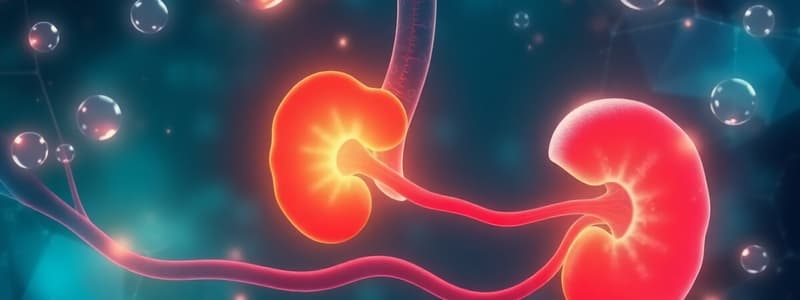Podcast
Questions and Answers
What is the role of thiazide diuretics in the treatment of nephrogenic diabetes insipidus mechanisms?
What is the role of thiazide diuretics in the treatment of nephrogenic diabetes insipidus mechanisms?
- They increase water retention by the kidneys.
- They enhance the effect of antidiuretic hormone (ADH) on renal tubules.
- They decrease sodium excretion leading to increased urine output.
- They promote sodium reabsorption in the distal convoluted tubule. (correct)
What risk is associated with administering two potassium-sparing diuretics?
What risk is associated with administering two potassium-sparing diuretics?
- Risk of acute renal failure.
- Risk of metabolic alkalosis.
- Risk of dehydration due to excessive diuresis.
- Risk of hyperkalemia. (correct)
Which hypothalamic nucleus is predominantly involved in the neurosecretory function affecting vasopressin?
Which hypothalamic nucleus is predominantly involved in the neurosecretory function affecting vasopressin?
- Lateral hypothalamic area.
- Supraoptic nucleus (SON). (correct)
- Dorsomedial nucleus.
- Arcuate nucleus.
Which condition would most likely warrant the use of a loop diuretic over a thiazide diuretic?
Which condition would most likely warrant the use of a loop diuretic over a thiazide diuretic?
How does reducing salt intake post-diuresis affect sodium retention?
How does reducing salt intake post-diuresis affect sodium retention?
What effect do thiazide diuretics with proximal tubular effects have when combined with loop diuretics?
What effect do thiazide diuretics with proximal tubular effects have when combined with loop diuretics?
What should be considered when selecting a diuretic for treating a condition with acute renal failure?
What should be considered when selecting a diuretic for treating a condition with acute renal failure?
What mechanism underlies the action of vasopressin receptor antagonists?
What mechanism underlies the action of vasopressin receptor antagonists?
What is the primary function of vasopressin in the human body?
What is the primary function of vasopressin in the human body?
Which of the following statements about vasopressin synthesis is correct?
Which of the following statements about vasopressin synthesis is correct?
Which part of the brain is primarily responsible for the production of vasopressin?
Which part of the brain is primarily responsible for the production of vasopressin?
How do vasopressin and oxytocin release from their storage site?
How do vasopressin and oxytocin release from their storage site?
In which circumstance is the scheduling of diuretic administration most effective?
In which circumstance is the scheduling of diuretic administration most effective?
What role does vasopressin play in the regulation of water permeability in the collecting duct?
What role does vasopressin play in the regulation of water permeability in the collecting duct?
Which of the following is a likely effect of vasopressin receptor antagonists?
Which of the following is a likely effect of vasopressin receptor antagonists?
Which receptor is primarily responsible for vasopressin's vasoconstrictor effects?
Which receptor is primarily responsible for vasopressin's vasoconstrictor effects?
Which of the following is NOT a mechanism associated with nephrogenic diabetes insipidus?
Which of the following is NOT a mechanism associated with nephrogenic diabetes insipidus?
In nephrogenic diabetes insipidus, what is primarily disrupted?
In nephrogenic diabetes insipidus, what is primarily disrupted?
What is the primary clinical use of antidiuretic hormone analogs?
What is the primary clinical use of antidiuretic hormone analogs?
Which medication may enhance the antidiuretic response to vasopressin?
Which medication may enhance the antidiuretic response to vasopressin?
Which of the following components is NOT part of the vasopressin prohormone structure?
Which of the following components is NOT part of the vasopressin prohormone structure?
What effect does chronic dehydration have on vasopressin's action in the kidneys?
What effect does chronic dehydration have on vasopressin's action in the kidneys?
What would be the expected physiological effect if vasopressin levels are elevated?
What would be the expected physiological effect if vasopressin levels are elevated?
Which diuretic action is associated with the activation of vasopressin?
Which diuretic action is associated with the activation of vasopressin?
Why are vasopressin-induced pressor responses minimal in vivo?
Why are vasopressin-induced pressor responses minimal in vivo?
What is the primary effect of vasopressin on ion transport in the kidneys?
What is the primary effect of vasopressin on ion transport in the kidneys?
What mechanism is responsible for the enhanced antidiuretic effects of carbamazepine and chlorpropamide?
What mechanism is responsible for the enhanced antidiuretic effects of carbamazepine and chlorpropamide?
Which drug is primarily used to treat central diabetes insipidus?
Which drug is primarily used to treat central diabetes insipidus?
What is the primary action of vasopressin receptor antagonists?
What is the primary action of vasopressin receptor antagonists?
In nephrogenic diabetes insipidus, which condition affects the kidney's response to ADH?
In nephrogenic diabetes insipidus, which condition affects the kidney's response to ADH?
What is a common clinical use of diuretics?
What is a common clinical use of diuretics?
Which mechanism allows mammals to concentrate urine in the collecting ducts?
Which mechanism allows mammals to concentrate urine in the collecting ducts?
What physiological condition is most directly associated with high circulating vasopressin concentrations?
What physiological condition is most directly associated with high circulating vasopressin concentrations?
Which substance inhibits vasopressin secretion?
Which substance inhibits vasopressin secretion?
In terms of vasopressin release, which change in blood volume has the least effect?
In terms of vasopressin release, which change in blood volume has the least effect?
Which pharmacological action is primarily known to influence urine osmolality related to vasopressin?
Which pharmacological action is primarily known to influence urine osmolality related to vasopressin?
What type of diabetes is characterized by a resistance to the effects of vasopressin?
What type of diabetes is characterized by a resistance to the effects of vasopressin?
What is the main effector peptide controlling vasopressin release in the brain's renin-angiotensin system?
What is the main effector peptide controlling vasopressin release in the brain's renin-angiotensin system?
What happens to vasopressin levels with large decreases in blood volume or pressure?
What happens to vasopressin levels with large decreases in blood volume or pressure?
Which of the following is not specifically mentioned as affecting vasopressin secretion?
Which of the following is not specifically mentioned as affecting vasopressin secretion?
Which condition leads to increased vasopressin secretion due to reduced arterial pressure?
Which condition leads to increased vasopressin secretion due to reduced arterial pressure?
What is the primary role of vasopressin in renal physiology?
What is the primary role of vasopressin in renal physiology?
Flashcards
Thiazide diuretic
Thiazide diuretic
A type of medication used to increase urine output by inhibiting sodium reabsorption in the kidneys.
Diuretic combination
Diuretic combination
Carefully combining different types of diuretics to avoid risks like hyperkalemia (high potassium levels).
Creatinine clearance
Creatinine clearance
A measurement of how well the kidneys filter waste from the blood, expressed in milliliters per minute.
Ceiling dose
Ceiling dose
Signup and view all the flashcards
Loop diuretics
Loop diuretics
Signup and view all the flashcards
Hyperkalemia
Hyperkalemia
Signup and view all the flashcards
Antidiuretic mechanism
Antidiuretic mechanism
Signup and view all the flashcards
Reducing salt intake
Reducing salt intake
Signup and view all the flashcards
Vasopressin Synthesis Location
Vasopressin Synthesis Location
Signup and view all the flashcards
Vasopressin Function
Vasopressin Function
Signup and view all the flashcards
Vasopressin Release Location
Vasopressin Release Location
Signup and view all the flashcards
Vasopressin Preprohormone Structure
Vasopressin Preprohormone Structure
Signup and view all the flashcards
Vasopressin Hormone
Vasopressin Hormone
Signup and view all the flashcards
Magnocellular Neurons
Magnocellular Neurons
Signup and view all the flashcards
Paraventricular Nucleus (PVN)
Paraventricular Nucleus (PVN)
Signup and view all the flashcards
Diuretic Administration Scheduling
Diuretic Administration Scheduling
Signup and view all the flashcards
Neurohypophysis
Neurohypophysis
Signup and view all the flashcards
Oxytocin
Oxytocin
Signup and view all the flashcards
Medullary Interstitium
Medullary Interstitium
Signup and view all the flashcards
Passive Countercurrent Multiplier Hypothesis
Passive Countercurrent Multiplier Hypothesis
Signup and view all the flashcards
What is the role of the TAL in the concentration process?
What is the role of the TAL in the concentration process?
Signup and view all the flashcards
How does ADH affect water reabsorption?
How does ADH affect water reabsorption?
Signup and view all the flashcards
Why is the ascending limb impermeable to water?
Why is the ascending limb impermeable to water?
Signup and view all the flashcards
Vasopressin's effect on collecting duct
Vasopressin's effect on collecting duct
Signup and view all the flashcards
Aquaporin-2
Aquaporin-2
Signup and view all the flashcards
V2 receptor activation
V2 receptor activation
Signup and view all the flashcards
Vasopressin's effect on Cortical collecting ducts
Vasopressin's effect on Cortical collecting ducts
Signup and view all the flashcards
Non-renal actions of vasopressin
Non-renal actions of vasopressin
Signup and view all the flashcards
Vasoconstriction
Vasoconstriction
Signup and view all the flashcards
NSAIDs and Vasopressin
NSAIDs and Vasopressin
Signup and view all the flashcards
Vasopressin's antidiuretic response
Vasopressin's antidiuretic response
Signup and view all the flashcards
Vasopressin-induced pressor responses
Vasopressin-induced pressor responses
Signup and view all the flashcards
Drugs enhancing Vasopressin's effect
Drugs enhancing Vasopressin's effect
Signup and view all the flashcards
Vasopressin Secretion Regulation
Vasopressin Secretion Regulation
Signup and view all the flashcards
Effective Blood Volume
Effective Blood Volume
Signup and view all the flashcards
Hemodynamic Regulation
Hemodynamic Regulation
Signup and view all the flashcards
Vasopressin and Hemodynamics
Vasopressin and Hemodynamics
Signup and view all the flashcards
Exponential Response
Exponential Response
Signup and view all the flashcards
Vasopressin and Antidiuresis
Vasopressin and Antidiuresis
Signup and view all the flashcards
Vasopressin Inhibitors
Vasopressin Inhibitors
Signup and view all the flashcards
Angiotensin II and Vasopressin
Angiotensin II and Vasopressin
Signup and view all the flashcards
Angiotensin III and Vasopressin
Angiotensin III and Vasopressin
Signup and view all the flashcards
Pharmacological Agents and Urine Osmolality
Pharmacological Agents and Urine Osmolality
Signup and view all the flashcards
Study Notes
Modulation of Pulmonary, Renal, and Cardiovascular
- Chapter 29: Drugs Affecting Renal Excretory Function / 557
- Chapter 30: Renin and Angiotensin / 585
- Chapter 31: Treatment of Ischemic Heart Disease / 607
- Chapter 32: Treatment of Hypertension / 625
- Chapter 33: Therapy of Heart Failure / 647
- Chapter 34: Antiarrhythmic Drugs / 667
- Chapter 35: Treatment of Pulmonary Arterial Hypertension / 695
- Chapter 36: Blood Coagulation and Anticoagulant, Fibrinolytic, and Antiplatelet Drugs / 709
- Chapter 37: Drug Therapy for Dyslipidemias / 729
Studying That Suits You
Use AI to generate personalized quizzes and flashcards to suit your learning preferences.




